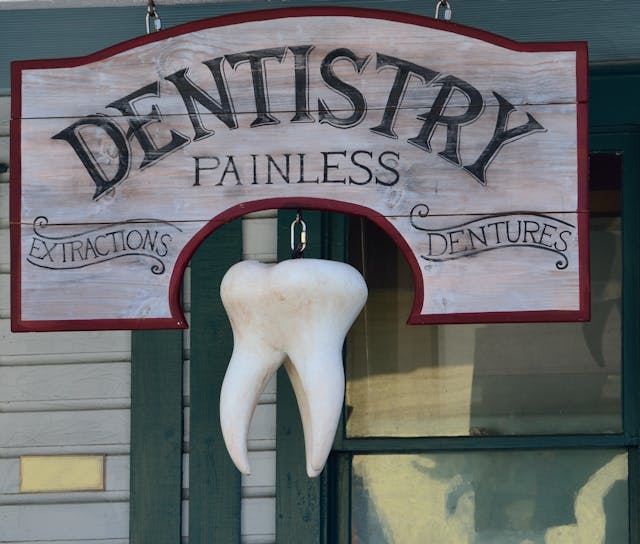
What is a cavity? It is a hole in the enamel of the tooth that bacteria can get in through.
We have 32 teeth, assuming you haven’t had your wisdom teeth out, and they are divided into three different types of teeth. We have incisors, canines, and molars. Incisors are the cutting teeth. The name comes from the Latin “incis”, which means “to cut”. We have eight incisors, four on the top and four on the bottom. The next two teeth are canines, which are the tearing teeth. They are not very pronounced in our mouths, but you can easily see them if you open your dog or cat’s mouth. Any carnivore has long pointed canines to rip meat off their prey. The name comes from the Latin “canis”, which means dog. The rest of the teeth are molars. We have eight premolars, eight molars, and four wisdom teeth, which are a type of molar. The molars are flat, and they are used for grinding food. We have this arrangement of teeth because we are omnivores. If you look in the mouth of a carnivore, they have very pronounced canines for ripping the meat, small incisors, and serrated molars to rip up the meat fibers. Their mouths have evolved to eat meat. Herbivores, on the other hand, have evolved to eat plants. They have strong flat incisors that can cut through tough plants, or grip while the animal uses its neck strength to rip the branch off. They often don’t have canines, and they have many more molars because plants need a lot of grinding.
Herbivores’ teeth constantly grow throughout their lives because plants are very rough, and they get worn down. Our teeth don’t. Once we lose our milk teeth and our adult teeth come in, those are all we get for the rest of our lives. That means they have to be very strong. They are protected by a very strong outer layer called enamel. Enamel is the strongest material our bodies can produce. Enamel is made of calcium phosphate, and it is stronger than bone because it is 95% mineral, while bones have other substances in them as well. Enamel is so strong because the calcium phosphate molecules make crystals, and those crystals join together to form fibers, about 50 nanometers wide. The fibers come together to make rods, which combine to make bundles, and these bundles make the shape of the tooth. All these layers make enamel very strong. Many of the fibers also continue down into the next layer of the tooth, holding the enamel firmly in place. The next layer down is dentin, which is harder than bone, but softer than enamel. It has to have some give because enamel is strong but brittle and the dentin is a shock absorber. Dentin is yellow and enamel is transparent, which is why your teeth look yellowish. The next layer down is the pulp, and this is where all of the nerves, blood vessels, and tissue are. Finally, there is the cementum layer, which is a bone layer that covers the root of the tooth and protects the ligaments that attach the tooth to the jaw.
So, what is a cavity? It is basically a hole through the tooth that goes into the soft pulp layer. The hard enamel layer is very strong, but it is not invulnerable. It can be dissolved by the acid that bacteria produce. Our mouths are full of bacteria, some good and some not good. Our saliva can kill some bacteria and every time we brush our teeth or use mouthwash, we remove the bacteria. However, when we eat a lot of sugar or starch, bacteria feed on them and start to reproduce like crazy. These bacteria produce a layer over the teeth that is called plaque. If you brush well, you can remove this plaque, but if you miss a spot, the plaque can harden and become tartar. The bacteria inside the tartar layer are safe from your brushing and can carry on eating sugar at their leisure. Every time they break down sugar, they produce acid as a byproduct and this acid begins to dissolve the enamel. It takes a long time because the enamel is very strong, but if the tartar is there for long enough, it is inevitable. The acid dissolves through the enamel and then through the dentin, which doesn’t take as long, before it gets right through into the pulp layer. You can’t feel the bacteria eating through the enamel and dentin, but when it hits the pulp, it triggers an immune response. The pulp layer starts to swell, and this presses the nerves because there is no space for the pulp to swell into inside the tooth. And this is where the pain comes from.
If a cavity is left untreated, the hole tooth will be damaged and it can cause damage to the roots of the tooth and even cause gum disease. However, if you visit your dentist regularly, it probably won’t get that far. Once enamel has been dissolved, it cannot be replaced, but the dentist can cut out the diseased part of the tooth and fill it with a filling, protecting the tooth. It is said that cavities are more common these days than they used to be because of the enormous increase in sugars and starches that we eat. However, that being said, dental health on a whole has improved and people visit their dentist far more frequently than they used to be. More people live with their real teeth for longer than people used to, so overall, things don’t look so bad. And this is what I learned today.
Photo by Pixabay: https://www.pexels.com/photo/dentistry-painless-signage-208474/
Sources
https://stonehavendental.com/the-different-types-of-teeth
https://www.hovedentalclinic.co.uk/blog/types-of-teeth
https://www.mayoclinic.org/diseases-conditions/cavities/symptoms-causes/syc-20352892
https://www.ucsf.edu/news/2010/08/101193/tooth-enamel-natures-crowning-achievement
https://en.wikipedia.org/wiki/Tooth_decay
https://daytonabeachdentalimplants.com/how-long-can-you-leave-a-cavity-untreated
